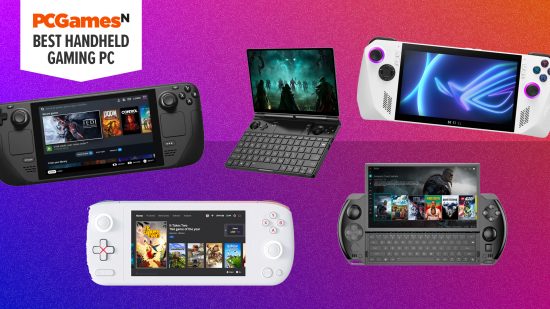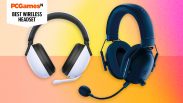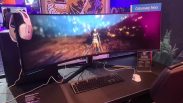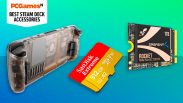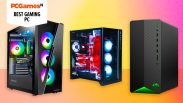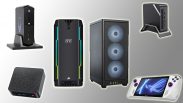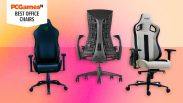Are you looking for the best handheld gaming PC? Valve ignited the handheld PC arms race in 2022 with the release of the Steam Deck. Still, it wasn’t the first, as a few older players have been iterating and improving their designs, alongside new competitors in the Asus ROG Ally and soon-to-be Lenovo Legion Go throwing their hat into the ring.
To make sense of this rapidly changing market, we’ve collated a list of all the best handheld gaming PCs. Unlike the best gaming PCs, these models have a portability factor that means you can carry them anywhere. We’ve taken a look at specifications, build quality, value, and software to sort the wheat from the chaff, even including something that might technically fit on our best gaming laptop list too.
We’ve already mentioned the venerable Steam Deck but you may be after something with a little more oomph – a question best answered by the Asus ROG Ally with its Z1 Extreme chip. If portability is your main concern, perhaps the Aya Neo Air may tickle your pickle with its minuscule footprint and vibrant OLED display.
If you’re all work and play then the GPD Win Max 2 and its novel convertible design may just hit two birds and one stone with its unique pairing of a controller and traditional laptop design.
There’s plenty to choose from, so read on to see what handheld gaming PC might be best for your hands.
These are the best handheld gaming PCs in 2023:
- Asus ROG Ally – best overall
- Steam Deck – best value choice
- OneXPlayer 2 – best screen
- GPD Win Max 2 – best convertible option
- Aya Neo Air – most portable option
- GPD Win 4 – premium choice
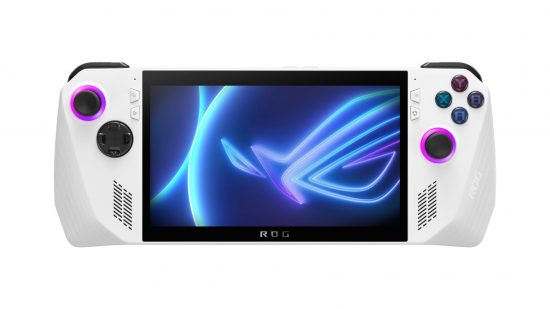
1. Asus ROG Ally
Best handheld gaming PC overall.
Asus ROG Ally specs:
| APU | AMD Ryzen Z1 Extreme |
| Cores | 8 |
| Threads | 16 |
| Graphics | 12 RDNA 3 CUs |
| RAM | 16GB LPDDR5 6400 MT/s dual channel |
| Display | 7” IPS 1080p/120Hz VRR |
| Storage | 512GB PCIe 4.0 SSD / microSD |
| Weight | 608g |
| OS | Windows 11 |
Pros
- 120Hz VRR display
- Fast Ryzen Z1 chip
- Big company backing
Cons
- MicroSD card overheating
- Armory Crate isn’t as good as SteamOS
The $699 (£699) Asus charges for its ROG Ally is a pittance compared to what smaller production-run companies such as OneXplayer, GPD or Aya Neo offer up, and whilst they cook up their own Zen 4-based handhelds, the ROG Ally stands head and shoulders above them.
The Z1 Extreme chip is enough to power most of the latest and greatest PC games, including Starfield mods designed to enhance the game’s performance.
The VRR display will greatly increase consistency when gaming too, with no screentearing. This means that you won’t have to stress about reaching a specific target like you have to with the Steam Deck. You can enhance the experience further by pairing it with the best Asus ROG Ally accessories.
One of the few areas for critique comes from a known issue with MicroSD cards. If you accessorize your Ally with a high-capacity NVMe drive, you’ll be fine, but in some cases, MicroSDs have gotten frazzled after overheating.
Armory Crate also isn’t the best handheld interface. Going in and using it can be a little clunky at the best of times, especially in the early days. Fortunately, you can just set up Steam Big Picture mode to initiate on launch and you will essentially have a very close experience to the Steam Deck – just without precompiled shader compilations.
The souped-up hardware and great build quality land it our top spot. If you love playing modern titles in particular, the Asus ROG Ally’s spec put it in a position to long out-last the Steam Deck.
Read our Asus ROG Ally review.

2. Steam Deck
Best value handheld gaming PC.
Steam Deck specs:
| APU | AMD Van Gogh |
| Cores | 4 |
| Threads | 8 |
| Graphics | 8 RDNA 2 CUs |
| RAM | 16GB LPDDR5 5500 MT/s quad channel |
| Display | 7” IPS 800p/40-60Hz (fixed) |
| Storage | 64GB eMMC, 256GB or 512GB PCIe 3.0 SSD |
| Weight | 669g |
| OS | SteamOS |
Pros
- Unmatched price-to-performance
- Huge aftermarket ecosystem
- SteamOS
Cons
- Lackluster screen
- Game compatibility
- Verification program isn’t always correct
Though the Steam Deck wasn’t the first handheld gaming PC, it is certainly the most important – and successful. Millions have been sold for a reason. The seamless integration with Steam and console-like experience means it can be as plug-and-play as you like – with the benefit of having a completely user-tweakable OS under the hood.
The lower-end 64GB model is one of the best discount handheld gaming PCs on the market, and it’s even cheaper if you opt for a refurbished model. You can also expand the storage and pair it with the best Steam Deck accessories to bring it up to snuff.
The custom APU dubbed Van Gogh is still plenty powerful for most games and if you mainly want to play through retro games, 2D games, sidescrollers, or emulated titles then you will be more than happy with the performance on offer.
That said recent titles such as Starfield, Star Wars Jedi: Survivor, and Remnant 2 cause the Steam Deck to misstep. Whilst we’re a little away from all major AAA releases being unplayable, the clock is ticking and you may feel you get more value if you opt for something a little newer.
The Steam Deck Verification program doesn’t always deliver either There have been a number of games that have been verified but clearly don’t work very well on the Deck. Sites like ProtonDB can offer a more nuanced take though so if you do your research – you shouldn’t run into too many snafus.
If you fancy customizing your Steam Deck, we’ve got guides on the best Steam Deck docks, cases, screen protectors, and skins.
Read our Steam Deck review.
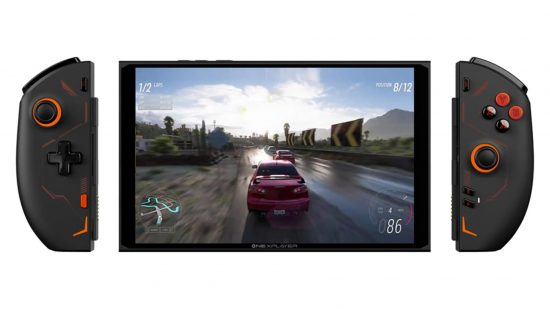
3. OneXPlayer 2
Best screen on a handheld Gaming PC.
OneXPlayer 2 specs:
| APU | AMD Ryzen 7 6800U |
| Cores | 8 |
| Threads | 16 |
| Graphics | 12 RDNA 3 CUs |
| RAM | 32GB LPDDR5x 6400 MT/s dual channel |
| Display | 8.4” IPS 2560 x 1600 |
| Storage | 2TB PCIe 4.0 SSD / microSD |
| Weight | 848g |
| OS | Windows 11 |
Pros
- Beautiful screen
- Detachable controllers
- Hall effect triggers
Cons
- Expensive
- Post-launch support
It might not have an OLED or VRR but the sharpness of such a resolution in such a small size makes for some unbelievably crisp visuals.
2D games – especially those with a pixel art design – will be as sharp as a pin. Though most new games won’t be able to make use of this resolution, OneXPlayer recommends bumping it down to 1200p which will scale nicely to its native resolution.
The controllers are detachable in a similar way to the Switch and the upcoming Lenovo Legion Pro meaning the OneXPlayer 2 is great as a small impromptu tablet. It’s worth keeping in mind that the controllers can’t connect together without a special bracket that is sold separately.
OneXPlayer has released a few products now but they don’t have the industrial might behind them like Asus or Valve do – making post-launch support a concern.
There is a good range of accessories to choose from to further enhance the OneXPlayer 2 experience though. There is a clip-on keyboard if you want to get some work done and the aforementioned controller bracket which means you wouldn’t have to bring a separate controller with you.
It is also very expensive but that price does afford you features you won’t find elsewhere right now. All of these features make it a great choice for someone who wants the most versatile gaming handheld PC with a gorgeous screen to drool over.
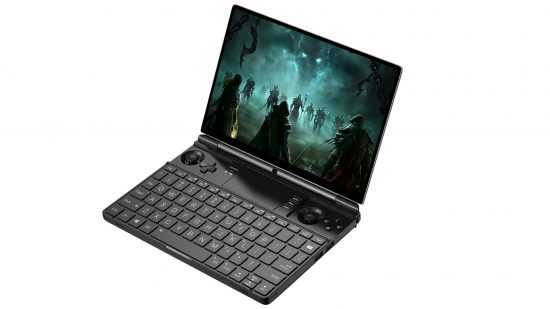
4. GPD Win Max 2
Best convertible handheld gaming PC.
GPD Win Max 2 specs:
| APU | AMD Ryzen 7 6800U |
| Cores | 8 |
| Threads | 16 |
| Graphics | 12 RDNA 3 CUs |
| RAM | 16GB LPDDR5 6400 MT/s dual channel |
| Display | 10.1” IPS 2560 x 1600 |
| Storage | 1TB PCIe 4.0 SSD / microSD |
| Weight | 1005g |
| OS | Windows 11 |
Pros
- Essentially a laptop
- Elevated eye position
- Great keyboard
Cons
- Unweidly
- Expensive
When you have work at 9 but emulation at 5. The GPD Win Max 2 is kind of the mullet of the gaming handheld PC world – business up front and party at the back. What makes this diminutive netbook a handheld gaming PC is the inclusion of the joystick and triggers. Furthering its credentials is the fact the joysticks use Hall Sensors so that you need never worry about stick-drift.
The shockingly useable keyboard is great for productivity tasks if you need the absolute smallest laptop on the go but it’s also great to have when text prompts appear in games or you like a lot of hotkeys. The 2560 x 1600 screen is very sharp too – just not quite as crispy as the OneXPlayer 2’s – so games and text will be very easy on the eye.
With the addition of a keyboard however, comes extra weight and the GPD Win Max 2 weighs a whopping 2.22lbs (1005g) so you might need to pump iron to comfortably hold it for longer than five minutes. To make up for this weight – your pockets will be markedly lighter as the GPD Win Max 2 costs a pretty penny.
Like other smaller manufacturers on this list, GPD may not have the production of scale to keep costs down but they have been in the business longer than anyone else with the original GPD Win debuting in 2016 and this expertise shines through in their products.
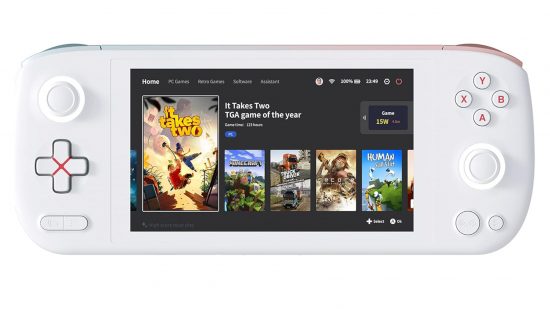
5. Aya Neo Air
Best portable handheld gaming PC.
Aya Neo Air specs:
| APU | AMD Ryzen 5 5560 |
| Cores | 6 |
| Threads | 12 |
| Graphics | 7 Vega 7 CUs |
| RAM | 16GB LPDDR4 4266 MT/s dual channel |
| Display | 5.5” OLED 1920×1080 |
| Storage | 512GB PCIe 4.0 SSD / microSD |
| Weight | 398g |
| OS | Windows 11 |
Pros
- Extremely light and portable
- Gorgeous OLED
- Hall Effect joystick and triggers
Cons
- Underpowered
- No suspend feature
The Aya Neo is a very slick and svelte package that isn’t as astonishingly expensive as some of the other non-Valve/Asus entries on our list today. It has an excellent OLED display that allows for great contrast levels with true-blacks and bright highlights making for a very vibrant and punchy image.
OLEDs have very good image persistence too so there will be no visible ghosting and input delays will be kept to a minimum given the very fast response time. Its pint-like statute means it will easily be stowed away in your bag and playing it on the go is far more practical than say with the comparatively monstrous Steam Deck.
The Steam Deck’s ace up its sleeve, however, is its suspend feature which allows you to pick up from where you left off, something that is sorely missed here given how convenient the Aye Neo Air is.
Another letdown is what’s powering the device under the hood. The Ryzen 5 5560U. This unfortunately doesn’t hold a candle to the RNDA 2 and RDNA 3-derived APUs powering the rest of our roundup.
This limits the Air to less processing intense games, but that still covers a lot of ground. 2D pixel games particularly and literally shine on the OLED panel, for example. That may well be more than enough for you – especially when combined with its smallness.
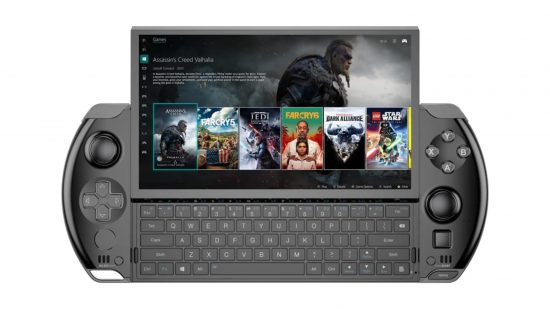
6. GPD Win 4
Most premium gaming handheld PC.
GPD Win 4 specs:
| APU | AMD Ryzen 7 6800U |
| Cores | 8 |
| Threads | 16 |
| Graphics | 12 RNDA 2 CUs |
| RAM | 32GB LPDDR5 6400 MT/s dual channel |
| Display | 6.1” IPS 1920×1080 |
| Storage | 1TB PCIe 4.0 SSD / microSD |
| Weight | 598g |
| OS | Windows 11 |
Pros
- Slick PSP-like design
- Sliding screen
Cons
- Cramped controls
- Expensive
Sony’s PSP is arguably one of the best-designed pieces of tech ever conceived and it’s clear GPD is of this persuasion as it seems they took everything great about that and improved the controls and added a keyboard hidden underneath a sliding screen.
Whilst being a similar price to other handhelds, this novel construction and quality design make it our pick for the most premium handheld gaming PC. Whilst the screen doesn’t slide up that much, it makes a noticeable difference and your neck will thank you if you play it for any length of time.
The keyboard is obviously not the most ideal typing experience but it’s surprisingly useable. It also blows the Steam Deck and ROG Ally’s touch keyboard out of the water. Powering the GPD Win Max 2 is the Ryzen 6800U, a very performant APU that will see more recent titles ticking along despite it not being the latest and greatest.
By taking inspiration from the PSP though, the controls can only be improved by so much and they are still more cramped and uncomfortable than most of the other entries in this list. It is of course rather expensive, but if you are a PSP purist, that may be a small price to pay.
How we chose the best handheld gaming PC
When compiling this list, we had several key areas to consider. Here’s how we decided what was worth a spot:
- Pricing: No matter how you look at it, buying a handheld gaming PC is going to be expensive, however, there’s still quite a range in costs, and we wanted to include options to accommodate everybody’s budget as much as possible so we wanted to include at least one option under $500. Going for cheaper options can be a bit risky because you might end up with a subpar piece of gear, but we only recommend options that are worth their salt.
- Processing power: Our top pick, the Asus ROG Ally, uses the AMD Ryzen Z1 Extreme, which means it should have no problem playing new triple-A games – both recent releases, and new ones that come out over the next couple of years. We recommend looking out for this if you enjoy playing all the latest games – of course, these sorts of games aren’t for everyone and anything running off the AMD Ryzen Z1 Extreme is going to carry a larger price tag.
- Portability: We’ve included a range of sizes here, as we appreciate that different gamers are going to look for different levels of portability. Do you want something to curl up on the sofa with? Or something you can easily bring with you when you’re out and about? Something like the Steam Deck or the Asus ROG Ally will be a little too big, but a smaller model like the Aya Neo Air will be much better suited to the task. Depending on your intended use for the PC, be sure to read up on the size and weight.
- Screen: Not only are you going to want to be conscious of screen size, but also what type of screen your chosen handheld PC has. If you go for one with an OLED screen, you’ll get exceptional picture quality, but it will cost a lot more. Meanwhile, an LCD screen can still look good (but not as good) and comes with a smaller price tag. We’ve included options that have a wide range of screens.
If you want to find out more about the process that goes into creating these lists, read our how we test page. Still questions? Read the FAQs below:
Are handheld gaming PCs good?
Yes, absolutely. They might be slightly less enjoyable to use for games that have been specifically designed with a keyboard and mouse setup in mind, but that’s just a small slither of the PC gaming pie. Handheld gaming PCs might actually offer a superior gaming experience for quite a lot of games and genres.
Which is the most powerful handheld gaming PC?
We recommend the Asus ROG Ally. Not only is this a fine choice for anybody who wants to place recent triple-A games, but it is a relatively future-proof choice too. We suspect that it will be a couple of years until it starts to struggle with big new releases.
Is PC more powerful than any console?
This is rather dependent on which PC you buy. If you buy a really old, outdated model, it might not be quite as powerful as a PlayStation 5 or an Xbox Series X. However, the chances are that if you go for a new gaming PC, you’re going to be getting something that’s more powerful than any console.
For more help choosing the right PC for you, read our guides on the best mini gaming PC, and how to build a gaming PC. You’ll have the ideal setup in no time.
